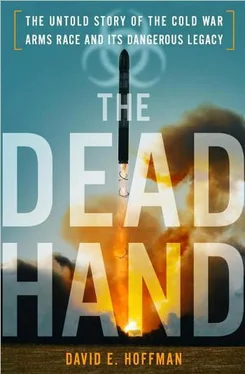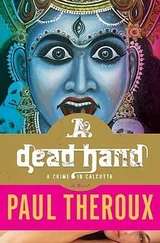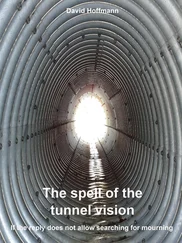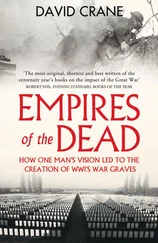The Westerners had brought their own plan of action for the visit to the complex, which had more than thirty buildings, and they split up into small teams. Davis was the person on the delegation with the most complete knowledge, and he needed to be in several places at once. He went with one team to Korpus 1, the large cubelike modern building in which each floor was dedicated to a different pathogen. But when another team in the older part of the complex found something interesting, he was asked to come over, and was driven there by the Russian hosts.
Davis happened upon an unmarked door that, he recalled, looked like that of a restroom. This opened into a shower changing room, and eventually a high-ceiling room containing a large freestanding hexagonal steel chamber, which Pasechnik had told them about. Biological bombs would be exploded inside the chamber, and animals, pinned down at one end, were exposed to the pathogens. Pasechnik had said the facility was used to test whether pathogens remained effective after being released by an explosive device.
They climbed inside the chamber. It was dark.
“Can we turn the lights on, I can’t see,” Davis asked. The Soviets said the bulb was burned out.
Davis reached for a small flashlight held by his trusted friend and deputy, Major Hamish Killip. Before Davis could turn the flashlight on, a Soviet official accompanying them grabbed his wrist and stopped him, saying it was a prohibited electronic device. They struggled back and forth. Davis protested strongly that he was on an officially sanctioned mission by the president of the Soviet Union. “We are your guests,” he insisted. “This is not the way to behave!”
“I wasn’t letting go of the flashlight, and he has ahold of me, and we’re in a standoff here. It was tense. They didn’t know what to do, and I wasn’t going to back off.” Eventually, the laboratory officials relented and managed to turn on the overhead light. 55Davis noticed the steel walls appeared to have been recently burnished, to erase any marks that would indicate explosive fragments. But when Davis looked at the door, which seemed to be double-skinned and made of a softer metal, he saw the telltale dents. What’s this? he asked.
The laboratory officials said it was poor workmanship with a hammer when the door was installed. “They knew that we knew this was laughable rubbish,” Davis said. Alibek remembered that Davis spoke up directly, saying, “You have been using explosives here.” Davis said the visit to the chamber was “pay dirt” showing the Soviets had an offensive biological weapons program, as Pasechnik had so painstakingly described. “It was quite chilling,” he said. The size of the equipment at Obolensk was a tip-off to the American and British experts that offensive weapons work was underway, and not just vaccines or defensive research. “You’ve got this gigantic building. You’re brewing up large quantities. You’re beginning to smell a rat here.”
Next, on January 14, the team went to Vector, the facility at Koltsovo where Popov had first experimented with genetic engineering. Sandakhchiev, the driven, chain-smoking Armenian who had once dreamed of creating a new artificial virus every month, began to give the foreigners a dull lecture on the latest advances in Soviet immunology, but the visitors, now alert to the Soviet delay strategy, cut him off. Davis and Kelly wanted to see the laboratories. “I could see their eyes widen with astonishment as we took them past enormous steel fermenters, larger than what any Western pharmaceutical firm would ever use for the mass-production of vaccines,” said Alibek. They were not permitted, however, to enter the most sensitive floors where virus research was being done.
At one point, a midlevel researcher let slip to Kelly that the laboratory was working on smallpox. Kelly asked him, quietly, through the interpreter, to repeat what he had just said. The researcher repeated it three times: Variola major . Kelly was speechless. The World Health Organization had eradicated smallpox, and samples were supposed to exist in only two official repositories, at the Centers for Disease Control in Atlanta and at the Ivanovsky Institute of Virology, a Ministry of Health facility in Moscow. Vector was not supposed to be working with smallpox; it was not supposed to have any smallpox. When Kelly later confronted Sandakhchiev, the director denied that offensive work was being carried out, and then refused to answer any more questions.
Alibek knew that one of Vector’s prize possessions was the 630-liter smallpox reactor, standing five feet tall, which could manufacture great quantities of the virus. The visitors took note of the reactor and other equipment, including the most advanced aerosol-testing capability any of them had ever seen. There could be no justifiable explanation other than an offensive biological weapons program, they concluded.
At the last stop, Pasechnik’s institute in Leningrad, Alibek thought he could relax. “The worst was behind us,” he later wrote. “Nothing at Pasechnik’s old institute would pose a threat. Or, so I thought.” All the incriminating equipment had been moved, and the laboratories scrubbed down.
Then, during the tour, one of the visitors stopped by an imposing machine and asked, “What’s this?”
“I groaned inwardly,” Alibek said. “I had forgotten about Pasechnik’s jet-stream milling equipment. It had been too heavy to move.” This was the machine that used a powerful blast of air to turn agents into a fine powder. An institute official proffered an explanation. “For salt,” he said. “That’s where we mill salt.”
The visitors saw machinery for preparing biological aerosols that would be the perfect size for sticking in the human upper respiratory system. And they saw equipment Pasechnik had alerted them about for disseminating pathogens from a low-flying craft, such as a cruise missile.
After the visitors left, Alibek felt victorious. Although the Westerners had suspicions, he recalled, “they could prove nothing, and we had given nothing away.”
The delegation knew they did not get a full view of Biopreparat, but they had seen enough. They wrote in their report: the sheer size and scope of the program, the configuration of the facilities, the nature and extent of the work on pathogens, the guards and physical security and the large aerosol experiments—all of it pointed to an offensive germ warfare effort that was far beyond anything needed for civilian purposes.
Pasechnik had told them the truth.
————— 16 —————
THE YEAR OF LIVING DANGEROUSLY
In the winter months of early 1991, nearly six years after the Politburo had chosen him as a younger, energetic standard-bearer who could save the party and state, Gorbachev, approaching his sixtieth birthday, felt exhausted. His attempt to create real, competitive politics gave rise to a potent rival, Boris Yeltsin, who became a rallying point for many who opposed Gorbachev, the establishment and the party. Nationalities long suffocated inside the Soviet Union began to awaken, with aspirations for independence, something Gorbachev had never foreseen.
Gorbachev’s perestroika , or restructuring—which began with a goal of rejuvenating socialism, and later was aimed at creating a hybrid of socialism and capitalism—was never a full-throated drive to free markets. Gorbachev had experimented with capitalism, and given permission for the first private entrepreneurs to set up their own businesses, known as the cooperatives. But shortages, disruption and hardship spread across the country. A catastrophic drop in oil extraction, along with low oil prices, took a heavy toll; foreign currency reserves were almost exhausted, and a lack of commercial credits made imports almost impossible. Flour was rationed. Gorbachev announced at a meeting of the Security Council one day in the spring that, in two or three months, the government would no longer be able to feed the country. 1And his halting half-steps away from the centrally planned economy led to demands, championed by Yeltsin, for a more radical leap to the free market.
Читать дальше












